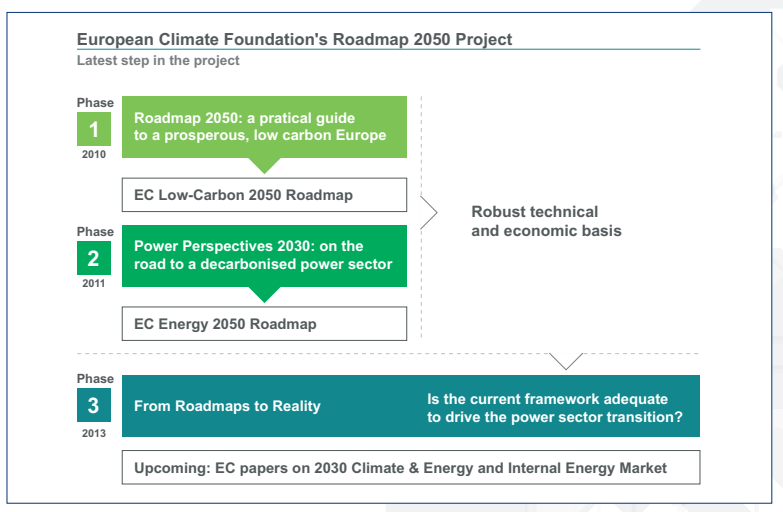From Roadmaps to Reality is the latest report in the European Climate Foundation’s larger Roadmap 2050 Project. That project so far produced two studies of a technical nature, Roadmap 2050: a practical guide to a prosperous, low-carbon Europe (2010) and Power Perspectives 2030: on the road to a decarbonised power sector (2011).
The first report, Roadmap 2050, provides a practical, independent and objective analysis of pathways to achieve a low-carbon economy in Europe, in line with the energy security, environmental and economic goals of the European Union. The second report, Power Perspectives 2030, describes the challenges and potential solutions facing the transition to a fully decarbonised power sector from a technical point of view.
From Roadmaps To Reality is of a different nature.
Unlike the previous studies, this report is not a quantitative technical analysis but a qualitative analysis of the current legal, policy and governance framework in the EU. Hence, it follows the shift in the debate in Europe from long-term scenario modelling to a conversation on real-world implementation challenges and policy frameworks.
For reasons of consistency and continuity, From Roadmaps To Reality refers primarily to the framing assumption and analytical findings of the prior two ECF studies. Still, most of these studies’ conclusions are echoed in the other roadmap exercises, despite their differences in scope, assumptions and analytical models used:
- Full decarbonisation of the power sector is a prerequisite for reaching the EU’s 80-95% emission reduction economy-wide.
- The system cost of electricity can be maintained at comparable levels over the next decades, with or without decarbonisation, but a substantial increase in upfront investments (Capex) is needed to benefit from reduced operational cost (Opex) later.
- Decarbonisation can enhance growth and security over the long term. While the rise in consumption of electricity is similar to BusinessAs-Usual (BAU), due to extensive electrification of heat and transport, the overall cost of energy per unit of Gross Domestic Product (GDP) in the decarbonised pathways declines substantially (20–30%) over the period relative to BAU, due primarily to greater energy efficiency in general and, in particular, efficiency gains associated with electrification.
- Given the expectation of increased demand for electricity in the heat and transport sectors, it is critical to reap the full potential for cost-effective energy efficiency.
- Continued build-out of a large portfolio of renewable technologies beyond 2020 is critical in every decarbonisation scenario. Focus on innovation and driving learning rates are important parts of the post-2020 decarbonisation agenda.
- Cross-border cooperation, integrating markets and sharing of resources can significantly reduce the overall costs of the power sector transition.
- As the share of variable renewable supply grows, flexible conventional generation, demand response (including distributed end-use energy storage devices) and transmission infrastructure are the most cost-effective levers to balance the power system. Beyond 2020, transmission capacity across the EU has to double compared to today.
- It is essential to make use of the time available. Implementation of new policies and regulations, orderly construction of new infrastructure, and a smooth build up of technology supply chains requires the full period about forty years. Delaying the transition will double the investment requirements in the 2020-2030 timeframe and increase overall cost.

The object of this report is to define a framework that enables governments in the EU to establish and stick to interim decarbonisation targets consistent with achieving the 2050 target.
The report is not starting from a blank sheet of paper.
Climate and energy law and policy has been the subject of intense activity at both EU and national levels in recent decades. In particular, the introduction of liberalised and competitive markets along with the requirement to reduce carbon emissions has created a complex tapestry of measures. The report starts from this reality and looks at how policy, legal and governance arrangements can be improved to meet upcoming challenges.
In the first chapter, the report describes they key features of the current EU framework and analyses its adequacy in relation to delivering the decarbonisation objective. In the second chapter, the report looks at the solutions at hand to tackle the identified challenges.
In the third chapter the report examines how these solutions can be brought together in a more robust EU framework on climate and energy.
Given the widely shared conclusion that early decarbonisation of the power sector is achievable and plays a central role in the decarbonisation of the wider economy, this report has the electricity sector at its core. Therefore, it can only bring a power-sector specific prospective on economy-wide instruments such as the EU ETS and the 2030 Climate & Energy package.
In addition, the report cannot explore in detail all aspects relevant to the power sector transition. The report, for example, provides a limited perspective on the interplay with gas, heat and transport sectors, or the role of distribution-level systems.
To see more :
https://www.roadmap2050.eu/attachments/files/Fromroadmapstoreality(web).pdf
